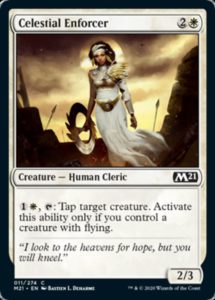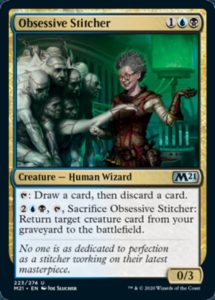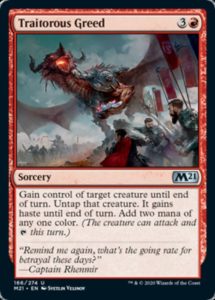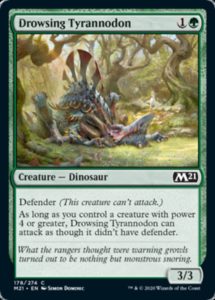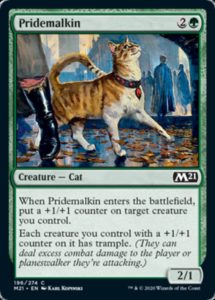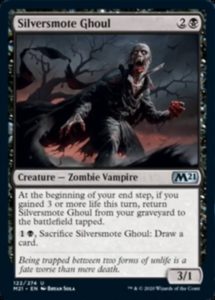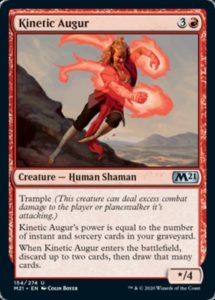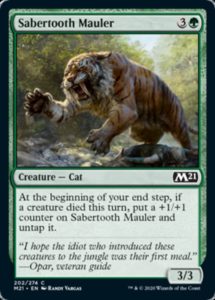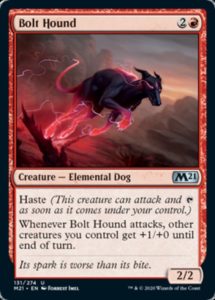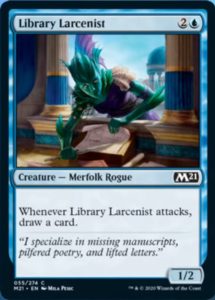Next Friday, Core Set 2021 comes out on Arena and Magic Online, meaning we’ve got a whole new Limited format to learn! It has ten distinct color pairs, each with its own theme—a step away from Core Set 2020’s mostly loose tricolor themes. While the full set spoiler won’t be out until later this week, there’s plenty of information about what each color pair is about.
M21’s archetypes are loud but modular, so you can commit heavily to them or mix and match (and there are clear crossover cards that support multiple archetypes). We’ve seen most of these archetypes before, but a couple are brand new. Red-white dog tribal takes advantage of dog finally (and adorably) replacing hound as a creature type, even if it might be mostly a twist on the very familiar RW go-wide archetype. Green-blue card-draw-matters has been been done as a major theme, though we’ve seen twists on it like drawing-two matters in Modern Horizons and individual cards like Fists of Flame). So, what are we looking to play with next week?
White-Blue Skies
Flying-matters is a common and solid choice, especially for a core set. The challenge with WU is that it’s often one of the slowest color pairs; and while it’s good to introduce players to a variety of aspects of the game, it’s best when someone’s first few head-to-head games don’t average 40+ minutes. Cards like Lofty Denial allow you to be tricky and controlling, but reward you for having relevant board presence and being able to apply pressure. It’s also an instance of a Threshold 1 mechanic, where possessing a single flying creature activates it (as with Celestial Enforcer)—normally, flying is rewarded as a go-wide archetype with cards like Favorable Winds.
How good WU will be depends on several factors. If removal is good, blocking is effective, Reach is in short supply, and common creatures aren’t too large across the board, then you should be able to gum up the ground and smash through in the air. If not, your undersized creatures might struggle.
Blue-Black Graveyard
UB appears to have one of the least cohesive themes, at least according to current set spoilers. Cards like Archfiend’s Vessel and See the Truth suggest that casting spells and reanimating creatures from the graveyard will be possible, but those might be Constructed plants rather than intended for Limited. Right now, the only revealed reanimation card is Obsessive Stitcher. This Dr. Frankenstein seems an incredibly powerful card, restricted only by her high mana cost and the availability of powerful reanimation targets.
There’s an interesting tension in UB. Teferi’s Tutelage and Thieves’ Guild Enforcer mill your opponents (which is now keyworded), but cards like Frantic Inventory reward you for milling yourself. We’ll know next week whether UB wants to grind through its own graveyard, attack its opponent’s library, or incidentally benefit from the graveyard.
Black-Red Sacrifice
We’ve seen this before and it doesn’t get old—it’s fun smacking your opponents with their own creatures and then not giving them back. Havoc Jester rewards you for sacrificing stuff, Dire Fleet Warmonger makes doing so easy, and Village Rites costs half as much as Altar’s Reap—an unnecessary boon when Traitorous Greed already pays for either one.
This is another smart archetype for a core set as it provides players a means of feeling smart while learning that some things are more important than keeping creatures alive.
Red-Green Ferocious… again?!
RG is perhaps the least subtle color in Magic, usually defined by big creatures, fight spells, creature keywords, and not a ton else. This can be a selling point, especially when folks are overwhelmed by the complexity and nuance of other color pairs, but I’m frankly shocked that Magic is bringing back Ferocious again. Ferocious was the least popular mechanic in Khans of Tarkir, but it’s somehow become the most reused mechanic in contemporary Magic. It was a theme (not merely on a single card or two) in Ravnica Allegiance, War of the Spark, and Theros Beyond Death, meaning it’ll be in four of the last seven sets.
Ferocious is a pretty simple mechanic and a good fit for a core set—it’s almost always a Threshold 1 mechanic where your cards power up if you have a single creature. It’s easy to track, since your creature’s stats are already important to you. And it slightly changes how you evaluate creatures. I’m just flummoxed as to why it’s become so popular internally and why Magic has decided that using unkeyworded mini-themes doesn’t unduly increase complexity.
Green-White +1/+1 counters
From the steppes of the Dromoka clans to the modularity of Eternal Masters, green-white loves +1/+1 counters. Pridemalkin demonstrates that the threshold for complexity in a core set is a bit higher, since it’s technically a +1/+1 counter lord at common.
GW tends to underperform when it’s as subtle as RG but has smaller creatures. Butonce +1/+1 counters get involved, its creatures can often be serious threats or play attrition games. When it has cards like Basri’s Acolyte, which plays into almost every green and white theme and is reminiscent of Saddleback Legac (perhaps the strongest green common in Oath of the Gatewatch), I’m excited to see what it can do.
White-Black Lifegain
We’ve come a long way from players being introduced to lifegain via cards like Throne of Bone. Now, you can learn that incidental lifegain is good by playing good cards rather than by trying to figure out that you lost because one of your cards was a complete blank.
We’re also seeing the first use of three life as a threshold (outside of Lone Rider)—four was the standard for M14’s Angelic Accord and Standard powerhouse Adanto Vanguard. The big question is how potent the payoffs are (Griffin Aerie seems strong if you can make it work) and how easy they are to enable (because you can’t keep chaining Revitalizes).
Blue-Red Spells
Prowess, the once evergreen, now deciduous mechanic is back; and it’s here to remind you that blue and red have the fewest creatures and the most spells. The challenge of this archetype is having enough spells (and payoffs) without compromising on quality. Everyone wants premium removal like Fire Prophecy, but it’s hard to justify including cards that aren’t creatures or removal. It’s especially harder to play a lot of spells when they don’t make creatures (as with Amass) or don’t need to be cast (as with Cycling).
Fortunately for the archetype, Wizards clearly knows that Prowess adds little to a card’s mana cost and that Wind Drake isn’t the most impressive card, so now we get the all-improved Mistral Singer. She’s fine on her own and deadly with a single trigger, which is the recipe for an excellent Prowess card.
Black-Green Morbid
BG is most associated with the graveyard. It often suffers from mechanics that risk being too strong in Constructed (here it’s easy to fill the graveyard) and too weak in Limited (where it’s night-impossible to interact with the graveyard). Now, BG has shifted focus to death happening on your turn and teaching players about the end step.
In other words, Morbid is back! It’s a sweet mechanic because it adds tension to combat and gives each player some control over it triggering. One always needs to wonder, “are they attacking to trigger Morbid or are they faking me out to sneak in damage?” That is a cool line of thought, and one that newer players don’t need to worry about.
Red-White Go-Wide Dogs
Just as BG is so often defined by the graveyard, RW is the color of the biggest armies. It looks like we’ll still see large armies of small creatures in Core Set 2021, but now they’ll be full of majestic and adorable dogs! I’m pretty darn excited about this development. I love dogs and it’s nice for them to get the spotlight when cats have gotten so much focus for the past several years.
Green-Blue Drawing Cards
While RW and BG tend to have a common mechanical foundation, GU is perhaps the least cohesive color combination. Its relatively dearth of quality removal and the gulf in how blue and green tend to play means the color combination is often just a multicolor goodstuff deck, unless there’s a plane-specific mechanic to play into. That trend seems to have been bucked in M21, as GU has a fairly novel (and dangerous mechanic): cards that reward you for drawing cards.
Drawing extra cards is among the most powerful things one can do in Magic. Accordingly, when it’s a major theme (as it was for UR in Throne of Eldraine), the payoffs tend to be anemic and require setup. But Lorescale Coatl is neither anemic nor difficult to use, and Burlfist Oak seems like an extra dangerous Landfall card since you’re guaranteed to have at least one trigger on all your turns. One wonders what the common payoffs will be—or perhaps there simply won’t be any (strong ones), since drawing cards is its own reward. Here’s looking forward to finding out the answers with the full set spoiler later this week and then when we get to play with it next Friday.
And, as always, thanks for reading.
—Zachary Barash is a New York City-based game designer and the commissioner of Team Draft League. He designs for Kingdom Death: Monster, has a Game Design MFA from the NYU Game Center, and does freelance gatame design. When the stars align, he streams Magic (but the stars align way less often than he’d like).

